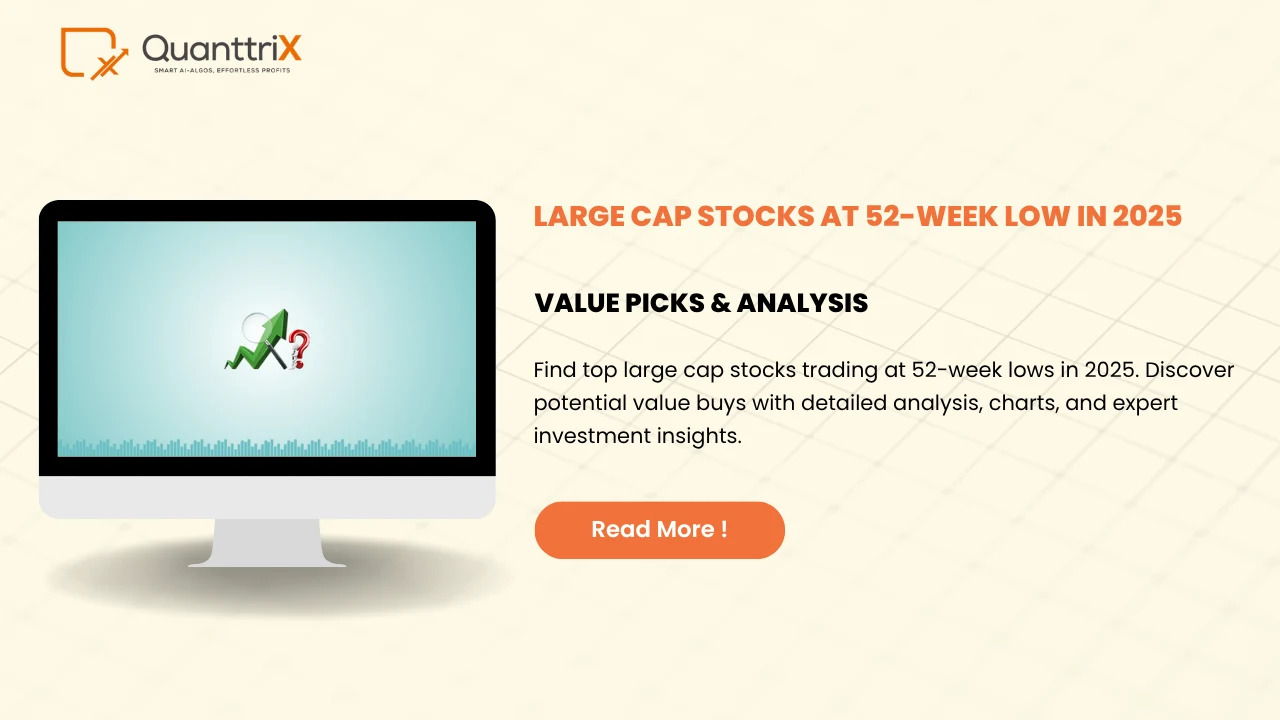Large Cap Stocks at 52-Week Low: An Opportunity or a Trap?
Introduction
Ever noticed how people love a good sale—whether it’s on clothes, gadgets, or even cars? But what if the same concept applied to the stock market? Imagine grabbing premium, high-quality companies at a discount. Sounds intriguing, right?
That’s exactly what 52-week low large cap stocks might offer: a golden chance to buy blue-chip companies at their lowest prices of the year. But before jumping in, we need to ask—are they on sale or on their way out?
In this guide, we’ll break down what is a large cap stock, explore current large cap stocks hitting their 52-week low, and even touch on how tools like algo trading software (and their prices) can give you an edge. We’ll keep things simple, conversational, and clear—even if you’re just starting out in the investing world.
Learn what is a large cap stock, explore 52 week low large cap stocks, and understand algo trading software price for smarter investing today.
What is a Large Cap Stock?
Let’s start simple. A large cap stock refers to a company with a market capitalization (total value of all its shares) of $10 billion or more. These are the household names—think Apple, Microsoft, or Coca-Cola. They’re often leaders in their industries, considered stable, and widely held by institutional investors.
In simpler terms? If the stock market were a high school, large cap stocks are the popular seniors everyone knows about.
Why Do Investors Care About Market Cap?
Market cap matters because it gives you a quick snapshot of a company’s size and risk level. Larger companies tend to be more stable, less volatile, and often pay dividends. That’s why many retirees and conservative investors love them.
But size isn’t everything. Sometimes big companies stumble too—leading to our next topic.
Understanding the 52-Week Low Metric
The 52-week low is the lowest price a stock has traded at in the past year. It’s like a stock’s lowest report card grade—and investors pay attention.
Why? Because when a stock hits this low, it may be undervalued… or heading for more trouble. That’s where deeper research comes in.
The Psychology Behind Low Prices
Here’s a quick analogy: imagine your favorite luxury car brand suddenly offering a model at 40% off. Your first thought? “What’s the catch?”
That’s exactly how the stock market works. When a large cap stock hits a 52-week low, emotions kick in—fear, greed, and hope all play their roles.
Understanding the psychology of price dips helps separate the smart investors from the reactive ones.
Are 52-Week Lows Always Bad?
Surprisingly, no. A 52-week low doesn’t automatically mean disaster. Sometimes external events—like interest rate hikes or global news—drag prices down even if the business is still strong.
In fact, some savvy investors look for large cap stocks at 52-week lows as buying opportunities.
How to Evaluate a Large Cap at 52-Week Low
Before you buy a stock just because it’s “on sale”, consider these steps:
- Check fundamentals: Is the company profitable?
- Review past performance: Is this a dip or a long-term decline?
- Look at industry trends: Are competitors also down?
- Study analyst opinions: What do experts say?
- Consider debt levels: Too much debt = risky.
Smart investors research first, buy second.
Examples of 52 Week Low Large Cap Stocks (2025)
Here are a few large cap companies hitting 52-week lows this year (based on July 2025 data):
- Intel Corporation (INTC) – Facing pressure from competitors like AMD and rising costs.
- Pfizer Inc. (PFE) – Declining post-COVID demand, but strong long-term pipeline.
- Boeing Co. (BA) – Struggles with supply chain and safety issues.
- Nike Inc. (NKE) – Soft global demand, but strong brand loyalty.
- Alibaba Group (BABA) – Impact from regulatory changes in China.
Note: These aren’t recommendations—just examples. Do your own homework!
Opportunities in a Downturn
They say, “Buy when there’s blood in the streets.” Sounds brutal, but the message is clear: downturns can lead to big gains—if you choose wisely.
Large cap stocks at a 52-week low may offer:
- Discounted entry points
- High-quality at low prices
- Good dividend yields
Think of it as buying blue-chip brands at Black Friday prices.
Risks You Shouldn’t Ignore
But be careful—some dips are warnings, not discounts.
Watch out for:
- Falling revenue
- Weak management
- Regulatory troubles
- Long-term industry decline
It’s like buying a car with a history of breakdowns—it might look shiny now, but will it get you far?
How Algo Trading Can Help
Ever wish you had a robot assistant to spot good stocks for you? That’s where algo trading (algorithmic trading) comes in.
Algo trading software uses data and mathematical models to:
- Identify patterns
- Make trades automatically
- Remove emotions from decisions
Think of it like autopilot for your investing journey.
Algo Trading Software Price and Features
If you’re curious about diving into automated trading, here’s what to expect:
- Entry-level software: $20–$100/month. Offers basic strategies and backtesting.
- Mid-tier platforms: $100–$500/month. Includes real-time data, portfolio management, and customization.
- Advanced solutions: $1,000+/month. Designed for hedge funds or serious traders.
Pro Tip: Don’t just look at the price—check support, ease of use, and integrations.
Manual vs Automated Trading: What’s Better?
Both methods have their pros and cons.
Manual Trading Pros:
- Full control
- More intuitive decisions
- Great for learning
Manual Trading Cons:
- Time-consuming
- Emotion-driven
- Slower reactions
Algo Trading Pros:
- Fast execution
- Backtesting capabilities
- Less emotional bias
Algo Trading Cons:
- Requires setup
- Higher cost
- Can fail in volatile markets
It’s like choosing between a stick shift and automatic car—pick what fits your style and skills.
Investor Emotions: Friend or Foe?
Believe it or not, emotions are the biggest risk in investing. Fear makes you sell too early, greed makes you buy too late.
The best investors stay calm, think long-term, and stick to a plan—even when markets get shaky.
Smart Strategies for Long-Term Gains
Want to make the most of large cap stocks at 52-week lows? Try these strategies:
- Dollar-cost averaging: Invest a set amount regularly.
- Diversify: Don’t put all your eggs in one basket.
- Hold for the long haul: Let time do the heavy lifting.
- Use watchlists: Track your favorite stocks for better timing.
The key is to think like a marathon runner, not a sprinter.
Conclusion: Sale or Slippery Slope?
So, are large cap stocks at 52-week lows a bargain or a bust? The truth is—it depends. Some may bounce back stronger than ever. Others might keep sinking.
The smart move? Do your homework, manage your risk, and consider using tools like algo trading software (even if you just start with a free version). And remember—investing isn’t about being perfect; it’s about being prepared.
FAQs
1. What is a large cap stock?
A large cap stock is a company with a market value of over $10 billion. These firms are usually well-established and stable.
2. Why do large cap stocks hit 52-week lows?
They may drop due to poor earnings, economic changes, sector downturns, or market overreactions.
3. Are 52-week lows good buying opportunities?
Sometimes yes—especially if the company is fundamentally strong and the drop is temporary. But not always.
4. How much does algo trading software cost?
Prices range from $20/month for basic platforms to over $1,000/month for advanced, professional-grade tools.
5. Is algo trading better than manual trading?
It depends. Algo trading is faster and emotion-free, but manual trading gives you more control and learning opportunity.









